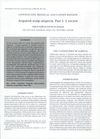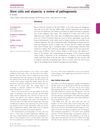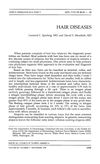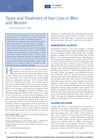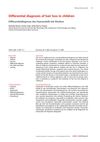Inflammatory and Non-Melanocytic Tumoral Pathology of the Nail
January 2014
in “
Pathology
”
non-scarring alopecia androgenetic alopecia alopecia areata follicular ostia follicular unit architecture sebaceous glands hair follicles biopsy transverse sections subungual melanoma melanonychia longitudinal melanonychia nail matrix RET mutation familial medullary thyroid carcinoma BRAF mutation papillary thyroid carcinoma hair loss male pattern baldness female pattern baldness hair biopsy nail cancer nail pigmentation thyroid cancer
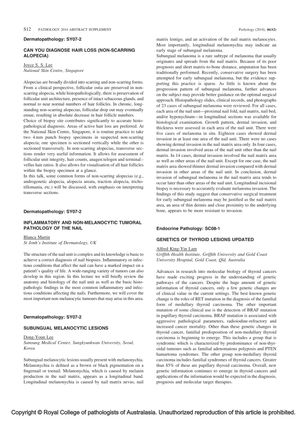
TLDR The document concludes that understanding nail anatomy is key for diagnosing nail diseases, early signs of nail melanoma may allow for less aggressive treatment, and specific genetic mutations are important in thyroid cancer prognosis and treatment.
The document discusses various topics in dermatopathology and endocrine pathology. In the section on non-scarring alopecia, Joyce S. S. Lee from the National Skin Centre in Singapore explains that non-scarring alopecias preserve follicular ostia clinically and follicular unit architecture histopathologically, with intact sebaceous glands and normal to near normal numbers of hair follicles. Chronic non-scarring alopecias may lead to a decrease in hair follicle numbers over time. Biopsy from areas of active hair loss and sectioning one specimen vertically and another transversely is recommended for accurate diagnosis, with transverse sections providing valuable information on follicular integrity and hair counts. Common forms of non-scarring alopecias, such as androgenetic alopecia and alopecia areata, were discussed with a focus on interpreting transverse sections.
Blanca Martin from St John's Institute of Dermatology in the UK covered the complex structure of the nail unit, emphasizing the importance of understanding its anatomy and histology for diagnosing nail biopsies. The lecture included common inflammatory and infectious conditions affecting nails and important non-melanocytic tumors that can develop in the nail area.
Dong-Youn Lee from Samsung Medical Center in Seoul, Korea, reviewed subungual melanocytic lesions, which often present as melanonychia, a brown or black pigmentation on nails. Longitudinal melanonychia can be an early sign of subungual melanoma, a rare and aggressive form of melanoma. The study reviewed 23 cases of subungual melanoma, assessing growth pattern, dermal invasion, and thickness in different areas of the nail unit. The findings suggested that dermal invasion in the nail matrix area occurs later than in other areas, indicating that conservative surgical treatment for early subungual melanoma may be justified.
Lastly, Alfred King-Yin Lam from Griffith Health Institute and Gold Coast University Hospital in Australia discussed the genetics of thyroid lesions, highlighting the clinical significance of RET mutation in familial medullary thyroid carcinoma and BRAF mutation in papillary thyroid carcinoma, which is associated with aggressive features and increased mortality. The document also mentions emerging genetic information in familial predisposition of non-medullary thyroid carcinoma, which could be important for diagnosis, prognosis, and targeted therapies.

